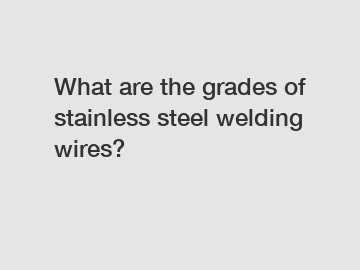What are the grades of stainless steel welding wires?
What are the grades of stainless steel welding wires?
Stainless steel welding wires are classified into different grades according to their chemical composition and physical properties. These grades dictate the suitability of the welding wire for specific applications and determine its mechanical, corrosion resistance, and heat resistance characteristics. In this article, we will explore the common grades of stainless steel welding wires, their origin, the process of justification, as well as their significance and impact in the field of welding.
The American Welding Society (AWS) has established a grading system for stainless steel welding wires that serves as an industry standard. The most commonly used grades are classified as AWS A5.9, which includes various subcategories such as ER308, ER316, and ER309. Each grade has unique properties and is designed for specific purposes.

The grades of stainless steel welding wires are derived from their chemical composition, primarily based on the percentage of alloying elements present in the wire. For instance, ER308 contains 19-21% chromium and 9-11% nickel, making it suitable for welding austenitic stainless steels. On the other hand, ER316 has additional molybdenum content, providing enhanced resistance to pitting and chloride ion corrosion in marine environments.
To justify the suitability of each grade for specific applications, extensive research and testing have been conducted. The properties and performance characteristics of stainless steel welding wires have been evaluated under various welding conditions, including different base materials, welding processes, and environmental exposures. These investigations have led to the approval of specific grades for specific applications, ensuring optimal weld quality and durability.
The significance of the grades of stainless steel welding wires lies in their ability to provide the desired mechanical properties, corrosion resistance, and heat resistance to the welded joints. By choosing the appropriate grade, welders can achieve strong and reliable welds that exhibit high tensile strength, good ductility, and resistance to cracking or failure. Moreover, the corrosion and heat resistance properties of the welding wires ensure that the welded joints can withstand harsh environments without compromising their integrity.
The impact of using the correct grade of stainless steel welding wire in various industries is significant. In the construction industry, for example, the use of ER308 welding wire ensures that welded structures, such as bridges and buildings, withstand external weathering conditions and maintain their structural integrity. In the food processing industry, where hygiene is of utmost importance, choosing the right grade, such as ER316, prevents the formation of crevices or corrosion in welded joints that could contaminate food.
In conclusion, stainless steel welding wires are categorized into different grades based on their chemical composition and properties. The grades are determined through extensive research, testing, and approval processes to ensure their suitability for specific applications. Choosing the correct grade of welding wire is crucial for achieving welds with desired mechanical, corrosion resistance, and heat resistance properties. The use of appropriate grades has a significant impact on the strength, durability, and reliability of welded structures across various industries.
For more plastic window screen factory, china brass wire mesh, china v beam mesh fencing manufacturerinformation, please contact us. We will provide professional answers.
179
0
0

Comments
All Comments (0)